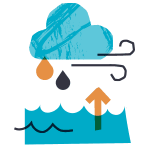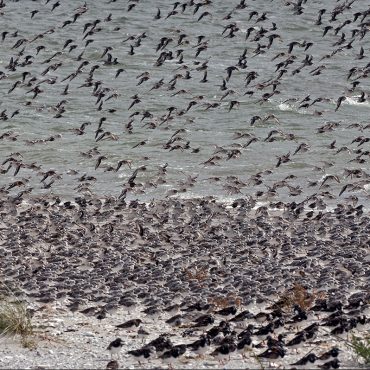A number of signs of rising sea levels have been observed along the North Sea and Wadden Sea coast. The global sea level is rising at a faster rate than we are observing in the North Sea and Wadden Sea and some future scenarios are predicting extremely high sea levels. The PRW (Programme towards a Rich Wadden Sea) has commissioned an analysis of the consistency between these indicators, the results of which are published in the report entitled Zeespiegelstijging langs de Nederlandse kust en de regionale bestuurlijke consequenties (Rising sea levels along the Dutch coast and the related regional administrative consequences).
PRW has commissioned this report as rising sea levels could potentially pose a major threat to both people and the ecosystem in the Wadden Sea region. However, what should we do if sea levels were to continue to rise slower than expected? Should we prepare for rapidly rising sea levels now or not?
Senior author Bart van den Hurk, under the guidance of the Wadden Academy, conducted this study based on existing scientific publications.The primary objective of the study is to explain and make connections between the backgrounds of recently conducted studies in order to help regional and national policymakers and professionals in the field of rising sea levels to gain an accurate understanding of the material.
Short term: the Greenland effect
It is indeed the case that no clear acceleration in the rise of the sea level in the North Sea and/or Wadden Sea has been established over the past century, in contrast to global sea-level measurements and observations. This is due in part to the strong influence of one-off weather events on the sea levels in the North Sea and Wadden Sea. Too little data is therefore available to visibly demonstrate a change in the speed at which the sea level is rising.
However, there are also systematic differences between the situation in the North Sea and the processes that dominate global sea levels. The relatively short distance between the North Sea and Greenland – which is responsible for a substantial proportion of the current rise in sea levels – is extremely important. The gravity of huge ice caps pulls up the water in its vicinity, so when the ice cap melts, two processes occur at the same time: the meltwater causes sea levels to rise worldwide, but causes the sea level nearer to the ice cap to fall as its gravitational pull decreases. As a result, Greenland’s contribution to the rising sea levels remains relatively small in the North Sea and Wadden Sea region.
Longer term: major influence from the Antarctic ice cap
In the longer term, there is a possibility that the ice cap in Antarctica will melt faster. As for its gravitational pull, the situation is exactly the reverse compared with Greenland: because Antarctica is far away from the Netherlands, the effects when it melts will only be greater. The longer term scenarios (starting around 2050), therefore give cause for vigilance.
Preparing for the long term
Based on the scenarios presented in the report, PRW still believes far-reaching measures to protect people and the ecosystem in the Wadden Sea region will be essential. In general, these measures (such as broader and more flexible types of coastal defence and raising of low-lying land with sediment from the sea) will require a long period of preparation. It is therefore important to keep the long-term perspective in mind at all times and simultaneously to start work on the preparations for these adjustments. PRW will therefore continue to promote and facilitate this process together with the parties involved in the Wadden Sea region, including via trilateral action involving Germany and Denmark.
For more information, please contact:
- Hein Sas (PRW): hsas@xs4all.nl / 06 53 19 34 95)
- Bart van de Hurk: Bart.vandenHurk@deltares.nl


